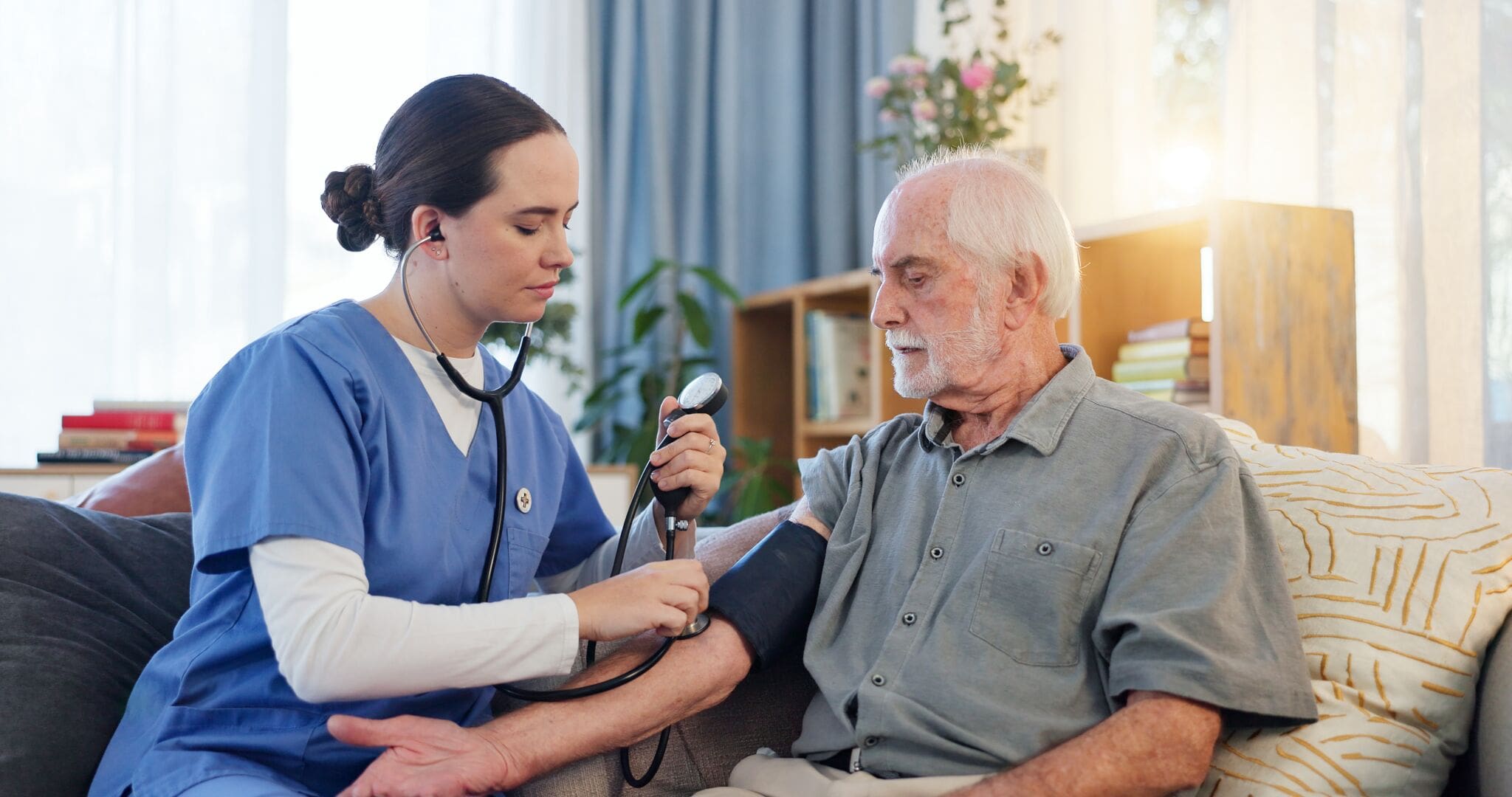In this article
What is complex PTSD (C-PTSD)?
Complex post-traumatic stress disorder (C-PTSD) is a psychological condition that emerges in response to prolonged, repeated or multiple traumatic events – particularly those that happen within close interpersonal relationships.
C-PTSD is different from standard PTSD, which typically follows a single incident, like a serious accident, natural disaster or violent assault. C-PTSD arises when a person experiences sustained trauma over weeks, months or years. People with the condition may have gone through chronic childhood abuse, domestic violence, human trafficking or captivity.
The NHS Long Term Plan highlights the need to expand trauma-informed services, recognising that standard PTSD treatments may fall short for those living with the effects of long-term or repeated trauma. Understanding C-PTSD as being shaped by both the trauma itself and the surrounding context allows practitioners to offer support that addresses the emotional and relational struggles that often make recovery so difficult.
How Complex PTSD differs from PTSD
The World Health Organization’s International Classification of Diseases, 11th Revision (ICD-11), recognises C-PTSD as a distinct diagnosis. It’s characterised by core PTSD symptoms alongside other ongoing difficulties.
PTSD core symptoms
PTSD is primarily defined by three symptom clusters:
- Re-experiencing the traumatic event (through flashbacks or nightmares)
- Avoiding reminders (situations or stimuli associated with the trauma)
- Hyperarousal (exaggerated startle response, irritability or insomnia)
These symptoms often arise following a single event. They can respond well to trauma-focused therapies that target the memory of that event.
What’s different about Complex PTSD?
C-PTSD includes all three core PTSD clusters alongside three additional symptoms:
- Affective (emotion) dysregulation – People with C-PTSD often struggle to manage intense emotions. They may feel overwhelmed by anger, sadness or fear, or go emotionally numb. Calming down can be difficult, and emotional reactions may seem sudden or extreme.
- Negative self-concept – C-PTSD can lead to a deep sense of shame or worthlessness. Many see themselves as broken, unlovable or fundamentally flawed – beliefs often rooted in how they were treated during trauma.
- Interpersonal difficulties – Trusting others and feeling safe in relationships can be hard. People with complex PTSD may pull away from closeness or become overly attached, often repeating patterns shaped by earlier experiences of harm or neglect.
These extra dimensions explain why C-PTSD benefits from a broader therapeutic approach.
PTSD treatment can centre wholly on processing a traumatic event, but complex PTSD interventions also need to focus on rebuilding personal narratives, strengthening emotional regulation skills and repairing relational patterns disrupted by long-term abuse or neglect.
UK mental health services often combine trauma-focused therapy with group sessions that teach practical skills and offer support for rebuilding trust and connection.

Common causes of Complex PTSD: Prolonged trauma and neglect
C-PTSD often develops in situations where people experience chronic trauma – situations they can’t or find it challenging to escape from. In these situations, they remain under the control of another person or institution.
In the UK context, common scenarios include:
- Childhood mistreatment: Prolonged emotional, physical or sexual abuse by caregivers, often coupled with neglect of basic needs and emotional validation
- Domestic abuse: Recurrent violence and coercive control by an intimate partner, where victims face constant fear, isolation and manipulation.
- Institutional abuse: Historical or contemporary harm within residential care settings – such as children’s homes, prisons or psychiatric hospitals. In these cases, power imbalances facilitate ongoing mistreatment.
- Human trafficking and exploitation: Individuals trafficked for labour or sexual exploitation experience systematic control, violence and deprivation over extended periods.
These contexts share core features: sustained exposure to threats, restricted autonomy and repeated breaches of trust. Victims often have limited opportunities to recover between traumatic incidents, leading to a cumulative impact on their developing sense of self and capacity for emotional regulation.
In many cases, the trauma begins in childhood, a critical period for attachment formation and identity development. As a result, adult survivors of child abuse often find it very difficult to regulate their emotions and relate to others.
Emotional dysregulation and identity disturbance
One of the hallmark features of complex PTSD is finding it very difficult to regulate emotions. Survivors often describe feeling overwhelmed by emotions that seem to surge without warning or explanation. At times, they may feel numb or disconnected from their emotional world. While this response is protective, it has negative effects – preventing the person from experiencing positive feelings such as joy or contentment. This emotional rollercoaster undermines stability, making it challenging to maintain a steady mood or respond proportionately to everyday stressors.
Identity disturbance compounds these challenges. Chronic trauma during formative years disrupts the development of a coherent sense of self. Survivors may experience a fragmented identity and confusing self-beliefs that alternate between self-loathing (“I am unlovable”) and grandiosity (“I am special because I survived”).
Such extremes can lead to impulsive behaviours – substance misuse, self-harm or risk-taking – as the person attempts to manage their inner turmoil or confirm a sense of aliveness.
C-PTSD treatment aims to rebuild emotional regulation and a cohesive identity. Interventions such as dialectical behaviour therapy (DBT) and Skills Training in Affective and Interpersonal Regulation (STAIR) focus on teaching grounding, distress-tolerance and mindfulness.
Over time, these therapies help people recognise and name their emotions without feeling consumed by them – creating space to make sense of their experiences and develop a steadier, more compassionate sense of self.
Interpersonal difficulties and trust issues
Complex trauma can deeply affect a person’s ability to form safe, supportive relationships.
Survivors of chronic abuse often learn early that those closest to them can harm them (or facilitate harm). This often leads to constant alertness and a deep fear of being let down or betrayed, manifesting as:
- Difficulty trusting others
- A reluctance to ask for help
- An intense fear of abandonment
Even well-meaning gestures may be seen as threats, prompting withdrawal, suspicion or defensive reactions.
On the other hand, some survivors can become overly attached, clinging to unhealthy relationships out of fear of being alone. This pattern – swinging between distrust and dependency – can be draining for both the survivor and those around them, reinforcing isolation and perpetuating the cycle of trauma. Friendships and partnerships often go through dramatic highs and lows – moments of intense closeness followed by sudden breaks – echoing the emotional turbulence of past abuse.
Therapy in this area focuses on developing secure attachment experiences within the therapeutic relationship itself. Therapists provide consistent empathy, boundaries and transparency, modelling what reliability and healthy connection can look like.
Group therapy can also play an important role. Being part of a supportive peer setting gives survivors the chance to practise being open, receive encouragement and observe how safe, respectful relationships work. Over time, these healing experiences can begin to shift how survivors see others, helping them rebuild trust and reconnect with people in a more balanced, fulfilling way.
Dissociation and flashbacks
Dissociation is an adaptive survival response to overwhelming trauma – a way for the mind to distance itself from what’s too painful to fully take in.
In C-PTSD, dissociative responses become entrenched. Survivors may find themselves:
- “Spacing out”
- Feeling disconnected from their bodies (depersonalisation)
- Sensing that the world isn’t real (derealisation)
These episodes range in duration and intensity, from brief moments of disconnection to longer stretches where time feels lost or memories are missing.
Flashbacks, unlike ordinary memories, are involuntary. They force the survivor to relive traumatic moments as though they are happening again.
Sensory cues – specific sounds, smells or images – can provoke these relived experiences, making the survivor feel as though they’re back in the traumatic moment. Flashbacks can be sudden and intense. The dissociative episodes can be terrifying, making the person feel powerless or on-edge.
Treatment usually starts with stabilisation before moving on to process the trauma itself. Grounding techniques – such as naming objects in the room, engaging each of the five senses methodically or using tactile prompts, like holding ice or textured fabrics – anchor survivors in the present moment.
Eye movement desensitisation and reprocessing (EMDR) and certain forms of trauma-focused cognitive behavioural therapy (TF-CBT) incorporate specific protocols to safely desensitise flashbacks, making them less frequent and emotionally overwhelming over time.
How Complex PTSD impacts daily functioning
The effects of complex PTSD touch every aspect of a person’s daily life.
Work can become a struggle as concentration lapses, emotional outbursts and hypervigilance interfere with professional demands. Many survivors struggle to hold down a steady job, resulting in financial instability and worsening stress.
For young people, it can be difficult to do well in school or university. They may experience flashbacks, avoidance or emotional ups and downs, all of which can affect attendance, focus and performance.
At home, everyday routines can feel like a mountain to climb. When the mind is stuck in cycles of trauma-related thoughts, even basic tasks may feel exhausting.
Parenting poses unique challenges: fears of repeating abusive patterns can lead to either over-protectiveness or emotional distancing from children. Relationships with partners and friends are similarly strained by mistrust, difficulty expressing feelings and unmet emotional needs.
Physical health also suffers. Chronic tension can cause problems with sleep, heart health and digestion. Some people turn to self-harm or substance use to try to cope, which brings its own set of risks. Over time, the weight of all these struggles can lead to additional mental health issues – such as depression, anxiety or addiction – making support from a range of professionals essential for recovery.
Diagnosis: ICD-11 criteria and NHS practices
In November 2018, the WHO’s ICD-11 formally recognised complex PTSD as a distinct diagnosis, differentiating it from PTSD based on its three additional symptoms.
Under UK NHS practices, diagnosis typically begins with a referral from a GP or mental health professional. Secondary care clinicians – usually psychiatrists or clinical psychologists – carry out comprehensive assessments that explore the person’s trauma history, the severity of their symptoms and how these affect their day-to-day life.
The International Trauma Questionnaire (ITQ) is increasingly used in NHS trusts as a self-report measure aligned with ICD-11 criteria. It allows clinicians to assess both PTSD and complex PTSD symptoms in a well-defined, consistent way. To explore other mental health conditions that might be present alongside trauma, professionals may also use structured interviews like the SCID (Structured Clinical Interview for DSM Disorders).
Getting an accurate diagnosis is vital – not only for selecting the best therapy options but also for accessing specialised trauma services funded by NHS England under the Improving Access to Psychological Therapies (IAPT) programme or local NHS trust provisions.
Given the complexity of C-PTSD, many NHS services adopt a staged approach to treatment:
- Initial stabilisation (helping the person feel safe and manage their symptoms)
- Trauma processing
- Rehabilitation and relapse prevention
This phased model helps ensure that people are not pushed into intensive trauma-focused therapy until they have developed the emotional regulation and coping strategies they need.
Screening and assessment tools
Effective screening and assessment kickstart C-PTSD care pathways.
In primary care and community settings, brief measures such as the Primary Care PTSD Screen for DSM-5 (PC-PTSD-5) or the Trauma Screening Questionnaire (TSQ) help identify those who need further evaluation. Schools, social services and voluntary sector organisations increasingly incorporate complex PTSD awareness into routine assessments for vulnerable groups, such as those in contact with child protection services or domestic abuse support agencies.
Within specialist mental health teams, the ITQ is a valuable tool for helping to tell the difference between PTSD and C-PTSD, as it measures key difficulties with identity, emotions and relationships – the three areas that define complex PTSD. Other tools, like the Dissociative Experiences Scale (DES), assess the extent of dissociative symptoms, while mood and anxiety scales (PHQ-9, GAD-7) assess whether the person is also experiencing depression or anxiety.
Assessment is carried out in a trauma-informed way, with a focus on safety and sensitivity. This means taking time, asking questions gently and being ready to offer support if someone becomes distressed during the process.
Multidisciplinary case formulations bring together insights from psychiatry, psychology, occupational therapy and social work, creating a coherent picture of the person’s needs. This holistic view helps shape a personalised care plan where interventions address both the core trauma symptoms and the wider social and practical factors that affect recovery.
Therapeutic approaches: Trauma-focused therapies
Evidence-based, trauma-focused therapies are key to C-PTSD treatment in the UK. Two approaches are especially well-supported in the NICE guidelines for PTSD, with adaptations for complex PTSD’s complexity:
- Trauma-focused cognitive behavioural therapy (TF-CBT) – This approach helps people challenge unhelpful beliefs about themselves and the world. It also encourages them to gradually reprocess traumatic memories that they have been avoiding. In C-PTSD, TF-CBT provides extra support on emotional regulation and skills development to address affective dysregulation.
- Eye movement desensitisation and reprocessing (EMDR) – This therapy uses bilateral stimulation (eye movements, taps or sounds) to guide people through a standardised eight-phase protocol. These steps target the vividness and emotional intensity of traumatic memories. For C-PTSD, EMDR therapists often allocate extra sessions to stabilisation, helping patients build strong grounding skills before beginning memory reprocessing.
Alongside these well-established approaches, newer therapies are gaining attention.
- Sensorimotor psychotherapy and somatic experiencing focus on how the body stores trauma, helping survivors release physical tension and make their body feel safer.
- Dialectical behaviour therapy (DBT) offers a structured set of skills – including managing distress, regulating emotions and improving relationships – that help survivors manage intense emotions and self-harm behaviours.
- Group-based programmes, such as skills training in affective and interpersonal regulation (STAIR), provide a safe way to practise new skills with others who understand the impact of complex trauma.
By combining individual and group approaches, UK services aim to address the multifaceted needs of C-PTSD, helping people make progress across different areas of life and maintain those improvements over time.
The role of medication and psychiatric support
While psychotherapy remains the primary intervention for C-PTSD, medication can help people manage the conditions that occur alongside it and target symptoms that make therapy challenging.
Doctors may prescribe selective serotonin reuptake inhibitors (SSRIs), such as sertraline or paroxetine, to ease depression and anxiety, both of which are common with C-PTSD.
For severe insomnia or hyperarousal, short-term use of sedating antidepressants or low-dose antipsychotics may be considered, but always under careful supervision from a psychiatrist.
If someone is struggling with ongoing dissociation, mood swings or traits linked to borderline personality disorder, mood stabilisers – such as lamotrigine – or certain atypical antipsychotics can help smooth out emotional highs and lows. This can give the person the stability they need to process their trauma.
All medication is prescribed in line with NICE recommendations. Doctors will carry out regular reviews to assess how effective they are as well as the impact of side effects. They will also review whether the patient still needs the medication and strive to prescribe the lowest effective doses for the shortest necessary time.
Psychiatric support goes beyond prescribing. In many NHS trusts, multidisciplinary clinics bring together psychiatrists, clinical psychologists and specialist nurses to review complex cases, adjust treatment plans and arrange referrals to inpatient or day-patient trauma services. These seamless, joined-up approaches ensure that medication decisions align with psychotherapeutic goals, with medication used to enhance, rather than replace, therapy.
Support networks and peer communities
Peer support networks also provide invaluable spaces for survivors to share their experiences. This can help them feel less isolated and interact with others who are modeling recovery pathways.
Within the UK, numerous charities and survivor-led groups operate local and online communities for those affected by complex trauma. These include:
- Trauma-informed support circles
- Creative arts workshops
- Facilitated discussion forums, where members exchange coping strategies and celebrate progress
- Peer mentoring schemes
Peer mentoring schemes, often coordinated by third-sector organisations, match people at different stages of recovery to offer mutual support and encouragement. This also provides a sense of accountability. For many survivors, connecting with others who truly understand the impact of prolonged trauma offers a sense of validation, which they don’t always find in professional settings. Online platforms – hosted by reputable organisations – make peer mentoring accessible for those in remote areas or with physical health limitations.
By strengthening the support system around the survivor, these networks contribute to sustainable recovery and resilience.

Challenges in accessing care
Despite growing awareness about C-PTSD, those affected still face numerous barriers in the UK system.
- Long waiting lists for specialist trauma services mean that many survivors put up with months of distress before they can get started with therapy.
- Funding constraints at both national and local levels often limit the availability of specialised programmes. People in some areas have to rely on generic mental health services, which can be ill-equipped for complex trauma.
- Stigma remains a serious obstacle. People may fear being judged if they disclose experiences of sexual or domestic violence. This leads to under-reporting and prevents people from getting the help they need.
- Cultural and linguistic differences can make things harder. Some communities lack culturally sensitive services or interpreters trained in trauma care.
Accessibility issues for people in rural populations also bring challenges, with fewer local mental health professionals and transport difficulties compounding the isolation of people with C-PTSD.
- To mitigate these gaps, some regions have piloted outreach services and digital therapy platforms that shorten waiting times and expand reach.
- Outreach clinicians provide assessments in community settings – such as children’s centres or women’s refuges – reducing the need for multiple appointments.
- Online programmes, delivered through the NHS-approved Improving Access to Psychological Therapies (IAPT) framework, allow survivors to begin coping skills training while they wait for face-to-face interventions.
Self-care strategies and grounding techniques
Empowering survivors with self-care strategies is helpful in C-PTSD recovery.
- Grounding techniques can be especially useful for managing flashbacks and dissociation. They anchor the person’s attention in the present moment. Examples include methodically naming five objects in a room, focusing on the sensation of the feet on the ground or carrying a small tactile object (like a smooth stone) to hold when feeling distressed.
- Breathing exercises – such as diaphragmatic breathing or the 4-7-8 technique – can help calm the body by activating the parasympathetic nervous system, which reduces feelings of stress and anxiety.
- Progressive muscle relaxation, body scans and mindful movement practices (gentle yoga or tai chi) can help build a sense of safety in the body.
- Journaling offers a private space to express and process emotions.
- Creative arts, like painting, music or dance, allow trauma to be expressed nonverbally. Trauma can’t always be communicated through words.
- Establishing simple daily routines is also important – balancing activity and rest, getting enough sleep, eating regular meals and including light exercise can all support emotional stability.
- Digital self-help resources, like the NHS-approved Mind Plan or HeadFIT tool (aimed at veterans) for stress management and mental well-being, offer guided modules on relaxation, mood tracking and coping skills.
Crucially, self-care plans are built on flexibility: survivors learn to tailor techniques to their current capacity, pacing themselves to avoid becoming overwhelmed and celebrating progress.
Resources for carers and loved ones
Supporting someone with C-PTSD can be tough emotionally, so it’s vital that carers and family members have access to tailored resources.
Mind’s Carers Information Service helps loved ones with understanding complex PTSD, navigating NHS services and looking after their own well-being. Carers UK provides peer support forums where family members share practical strategies for boundary-setting, communication and self-care.
Training workshops – often run by local NHS trusts or charities – equip carers with skills in trauma-informed listening, crisis de-escalation and safeguarding. Online courses, such as those offered by Anna Freud, introduce key ideas in trauma theory and resilience-building.
These resources enable carers to recognise signs of distress, have supportive conversations and know when to seek professional help.
Looking after their own mental health is just as important for carers. Staying socially connected, accessing counselling or peer support and setting clear boundaries all help prevent burnout. By maintaining their own well-being, carers are better placed to offer consistent, compassionate support – creating a safe and steady environment where their loved ones can begin to heal.






